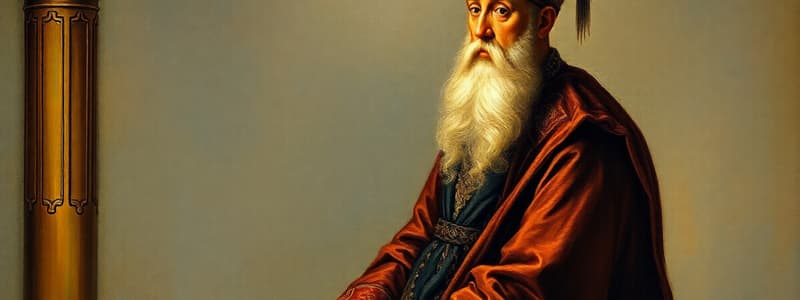Podcast
Questions and Answers
In 1453, Mehmet II took ______, destroying the Byzantine Empire.
In 1453, Mehmet II took ______, destroying the Byzantine Empire.
Constantinople
The Ottoman Empire was divided into provinces known as ______ governed by local authorities.
The Ottoman Empire was divided into provinces known as ______ governed by local authorities.
wilayas
Selim, the grandson of Mehmet II, defeated the Safavid dynasty in ______.
Selim, the grandson of Mehmet II, defeated the Safavid dynasty in ______.
Persia
The Ottoman Empire's unity resided in ______ rather than in the spoken language or ethnicity.
The Ottoman Empire's unity resided in ______ rather than in the spoken language or ethnicity.
The ______ system provided special protection for Christian and Jewish minorities within the Ottoman Empire.
The ______ system provided special protection for Christian and Jewish minorities within the Ottoman Empire.
The Ottoman Empire was often referred to as the 'sick old man of ______'.
The Ottoman Empire was often referred to as the 'sick old man of ______'.
The Treaty of Carlowitz (1699) resulted in the loss of ______ and most of Hungary for the Ottoman Empire.
The Treaty of Carlowitz (1699) resulted in the loss of ______ and most of Hungary for the Ottoman Empire.
The Treaty of Berlin (1878) divided Greater Bulgaria into three parts, affecting the regions of ______, Rumelia, and Macedonia.
The Treaty of Berlin (1878) divided Greater Bulgaria into three parts, affecting the regions of ______, Rumelia, and Macedonia.
During the Napoleonic invasion of Egypt (1798), communication routes between ______ and its empire in India were disrupted.
During the Napoleonic invasion of Egypt (1798), communication routes between ______ and its empire in India were disrupted.
Russia aspired to gain access to the Black Sea and the ______ Sea, considering itself the heir to the Byzantine Empire.
Russia aspired to gain access to the Black Sea and the ______ Sea, considering itself the heir to the Byzantine Empire.
Flashcards are hidden until you start studying
Study Notes
Rise and Development of the Ottoman Empire
- Osman I, a Turkish mercenary converted to Islam, is credited with founding the Ottoman Empire in the late 1200s.
- His successors expanded Ottoman rule across Asia Minor and the Balkans.
- Mehmet II conquered Constantinople in 1453, effectively ending the Byzantine Empire.
- The Ottoman Empire was divided into provinces called wilayas, each governed by local authorities with varying levels of autonomy, but all under a centralized tax system.
- The Ottoman Empire was multifaith and multi-ethnic, with Islam holding political dominance and Christian and Jewish minorities enjoying special protection through the millet system.
Decline of the Ottoman Empire
- The empire's decline was influenced by a combination of domestic and external factors.
- Domestic factors:
- Cessation of conquests, weakening of the imperial institution, and technological backwardness.
- External factors:
- New geographical discoveries and changing trade routes, expansion of European capitalism and the Capitulation Regime, European powers' inability to agree on how to divide the Ottoman Empire.
Colonial European penetration of the Ottoman Empire
- The Ottoman Empire began losing territory through treaties like the Treaty of Carlowitz (1699) and Treaty of Kuchuk Kainaryi (1774), which granted Russia significant concessions and influence.
- Napoleonic invasion of Egypt in 1798 disrupted the communication route between England and its Indian empire and established French influence in Egypt.
- The Treaty of St. Stefano (1878) granted independence to Serbia, Romania and Montenegro.
- The Treaty of Berlin (1878) reorganized the Balkans, dividing Greater Bulgaria and granting varying degrees of autonomy.
Powers' interests over the Ottoman Empire
- Russia: Considered itself the heir to the Byzantine Empire and sought access to the Black Sea and Mediterranean.
- England: Advocated for Ottoman integrity to contain Russian expansionism and secure its imperial communication routes.
- France: Allied with England against Russian expansionism and expanded its control over Algeria, Tunisia, and Morocco.
- Germany: Primarily interested in commercial and financial opportunities within the Ottoman Empire.
- Italy: Sought control of the north coast of Africa and occupied Libya and the Dodecanese islands.
Growing European Influence and Introduction to Western Models
- The Ottoman Empire saw a growing presence of European counselors, administrators, diplomats, teachers, and missionaries, who introduced Western ideas and policies.
- Christian missions acted as agents of European powers and fueled the dissemination of western culture and the development of an intellectual and educational movement.
- The young Ottomans who studied in Europe introduced Western ideas to the empire.
- Sultan Selim III imported European technology , primarily military.
- Mahmud II destroyed the Janissars in 1826, paving the way for the establishment of a modern European-style army.
- The Tanzimat period (1839-1876) expanded reforms to other fields.
Arab Nationalism: Pan-Turkism, Ottomanism, and Pan-Islamism
- During the nineteenth century, the idea of a nation based on ethnic-linguistic belonging gained popularity in Ottoman territories.
- The Ottomans adopted Pan-Turkism, Ottomanism, and Pan-Islamism to counter these nationalist trends.
- Pan-Turkism: Aimed at unifying all Turkish populations under the Ottoman dynasty.
- Ottomanism: Promoted a sense of shared national identity among various ethnic groups and religious communities within the empire.
- Pan-Islamism: Sought to unite Muslim populations around the Ottoman Empire, symbolizing political and religious unity.
Studying That Suits You
Use AI to generate personalized quizzes and flashcards to suit your learning preferences.



